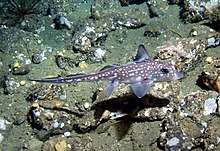Holocephali
The subclass Holocephali ("complete heads") is a taxon of cartilaginous fish in the class Chondrichthyes. The earliest fossils are of teeth and come from the Devonian period. Little is known about these primitive forms, and the only surviving group in the subclass is the order Chimaeriformes. This group includes the rat fishes in the genus Chimaera, and the elephant fishes in the genus Callorhynchus. These fishes move by using sweeping movements of their large pectoral fins. They have long slender tails and live close to the seabed feeding on benthic invertebrates. They lack a stomach, food moving directly into the intestine.
| Holocephali | |
|---|---|
 | |
| Hydrolagus colliei, a rat fish | |
| Scientific classification | |
| Kingdom: | Animalia |
| Phylum: | Chordata |
| Class: | Chondrichthyes |
| Subclass: | Holocephali |
| Orders | |
Characteristics
Members of this taxon preserve today some features of elasmobranch life in Paleozoic times, though in other respects they are aberrant. They live close to the bottom and feed on molluscs and other invertebrates. The tail is long and thin and they move by sweeping movements of the large pectoral fins. The erectile spine in front of the dorsal fin is sometimes venomous. There is no stomach (that is, the gut is simplified and the 'stomach' is merged with the intestine), and the mouth is a small aperture surrounded by lips, giving the head a parrot-like appearance. The only surviving members of the group are the rabbit fish (Chimaera), and the elephant fishes (Callorhynchus).[2][3]
Evolution
The fossil record of the Holocephali starts during the Devonian period.[4] The record is extensive, but most fossils are teeth, and the body forms of numerous species are not known, or at best poorly understood. Some experts further group the orders Petalodontiformes, Iniopterygiformes, and Eugeneodontida into the taxon "Paraselachimorpha", and treat it as a sister group to Chimaeriformes. However, as almost all members of Paraselachimorpha are poorly understood, most experts suspect this taxon to be either paraphyletic or a wastebasket taxon.
Based on genetic research, it is estimated the Holocephali split from the Elasmobranchii about 421 million years ago.[5] A 280 million-year-old fossil called Dwykaselachus oosthuizeni show the group was more shark-like in its earlier days.[6]
| Taxonomy according to Joseph Nelson, 2006[7] |
|---|
† Extinct * position uncertain |
References
- Coates, M., Gess, R., Finarelli, J., Criswell, K., Tietjen, K. 2016. A symmoriiform chondrichthyan braincase and the origin of chimaeroid fishes. Nature. doi:10.1038/nature20806
- Pough, Janis & Heiser 2013, pp. 99,101, Table 5-1.
- Martin, lead section.
- Pough, Janis & Heiser 2013, pp. 103,105, Paleozoic Holocephalans.
- Renz, AJ; Meyer, A; Kuraku, S (2013). "Revealing less derived nature of cartilaginous fish genomes with their evolutionary time scale inferred with nuclear genes". PLoS One. 8: e66400. doi:10.1371/journal.pone.0066400. PMC 3692497. PMID 23825540.
- 280 million-year-old fossil reveals evolutionary origins of shark-like fishes
- Nelson 2006.
Bibliography
- Martin, R. Aidan; et al. "Chimaeras — The Neglected Chondrichthyans". Biology of Sharks and Rays. ReefQuest Centre for Shark Research. Retrieved 2016-02-22.CS1 maint: ref=harv (link)
- Nelson, Joseph S. (2006). Fishes of the World. ISBN 978-0-471-25031-9.CS1 maint: ref=harv (link)
- Pough, F. Harvey; Janis, Christine M.; Heiser, John B. (2013). Vertebrate Life (9th,international ed.). ISBN 978-0-321-78235-9.CS1 maint: ref=harv (link)